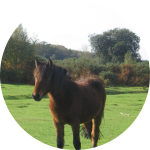| Home |
Welcome to the Horse Stall |
|
Horse Stall contains all types of information for Horse Lovers.
There are a number of products branded horse gifts and products.
Horse Articles :: Horse Breed Glossary - M
|
Horse Breed Glossary - M |
|
MOYLE HORSE A man by the name of Rex Moyle created the Moyle breed of horses in Idaho during the middle of the 20th century. He used mustangs that had been brought into Idaho from Utah. Moyle horses are light riding horses that are normally bay or brown and they have front horns. The breed is rare. MURGESE HORSE A light riding horse and draft horse that is similar to the Friesian, the Murgese is found in Italy. The breed is rare. Most often in black, the Murgese is also ocassionally gray. They are descendants of Oriental horses that were crossed with local horses. There is a Murgese herdbook established in 1926. MUSTANG HORSE Sometimes referred to as the American Feral Horse, the Mustang breed is found wild in the western United States. Mustang is from a Spanish word, "mesteno" which means "wild" or "Stray". Mustangs were originally Spanish horses, but over the years and due to their roaming qualities, they have now become a mix of several breeds. European settlers brought their own horses into the west; Indian raids and freed wild stallions tore down domestic fences and joined the tamed horses; and Indians captured horses between tribes and bartered which contributed to the distribution of Mustang horses and mix of breeding. The United States government purchased 150 horses from Germany every year for 10 years between the 1800's and 1900's. The East Friesian horse was a heavy warmblood that could pull heavy wagons and artillery- but some escaped and their blood was mixed with the Wild Mustangs of the west. The herds of Mustangs started to cause problems when the western United states became settled and the land was needed for cattle to graze. Some mustangs were shot to the point that the population was cut in half by 1926. A Wild Free Roaming Horse and Burro Act was passed by Congress in 1971 that helps protect these horses. The population of Mustangs grew again, until they were too numerous once again. The Adopt-a-Horse program in 1973 began in Montana to help distribute excess Mustangs in a humane way. Individuals can adopt a horse for $125 provided they meet certain requirements. The government actually owns the adopted horses for a year after adoptions, until a veterinarian statement is produced to show the horse is under good care. Most Mustang horses are warmbloods, and the coat colors can be any colors found on horses. Some still exhibit Spanish characteristics despite that blood being very diluted in the breed. NATIONAL SHOW HORSE A registry called The National Show Horse Registry was created in order to meet the need within the equine industry for athletic horses with beauty that could be shown in the ring. The breed has the refinement and stamina of the typical Arabian horse, and a high-stepping movement like the American Saddlebred. In 1981, the National Show Horse breed was born. The registry has taken every possible step to be sure that a wide variety of combinations of the Arabian and American Saddlebred bloodlines produce a high quality horse. New concepts and horse shows have been developed in which to show these fantastic horses, and a high prize money system encourages spectators and exhibitors to participate. NEW FOREST PONY The New Forest Pony is named for and was originated from a forest located in southern England. Of the mountain and moorland ponies in the British Isles, the New Forest Pony is the most recognized breed. They are known for their strength, willing to please temperaments, intelligence and versatility. The size of New Forest Ponies are usually between 12 and 14 hands. They are often brown, bay and gray colored, although some chestnuts, blacks and roans can be seen. The registry allows a few white markings on legs and head. Well bred New Forest Ponies have a free and straight movement, strong quarters, body debth and be a good riding horse. Their versatility allows them ability to participate in Pony Club, Dressage and Polo-Driving, as well as gymkhana and jumping. Many New Forest Ponies are used for training to carry handicap riders. New Forest Ponies are extremely gentle and they are often used for children's horses. They can carry light weight adults as well, and are an ideal driving pony. About the Author |
Top Horses |
|
| Top Horse Movies | |
Horse Resources |
|
Horse Health |
|
Horse Breeds |
|
More Horses |
|


| Copyright 2005-2021 DR Management All rights reserved |
Dog Gifts | Wildlife Gifts | Handmade Horse Gifts |
